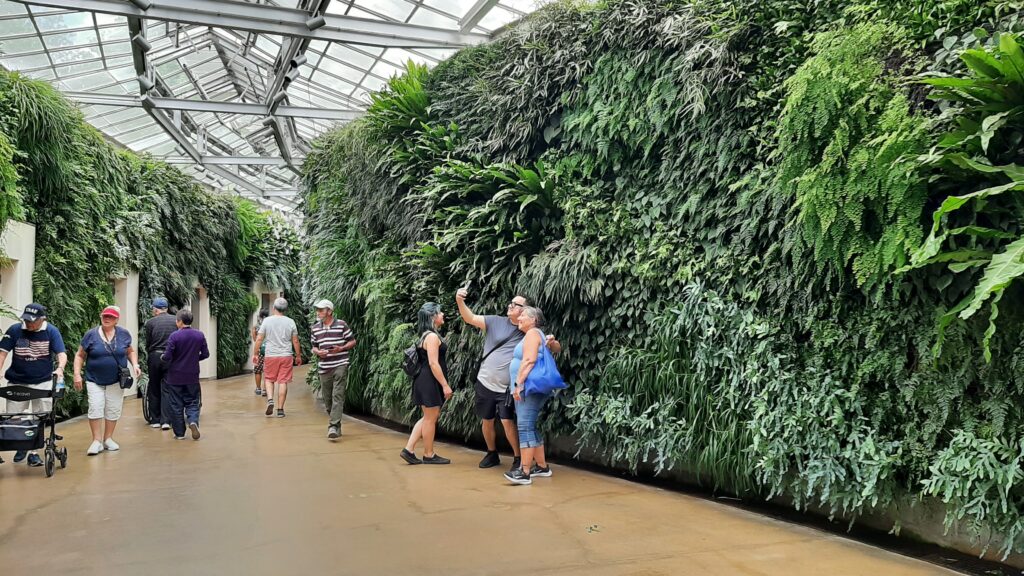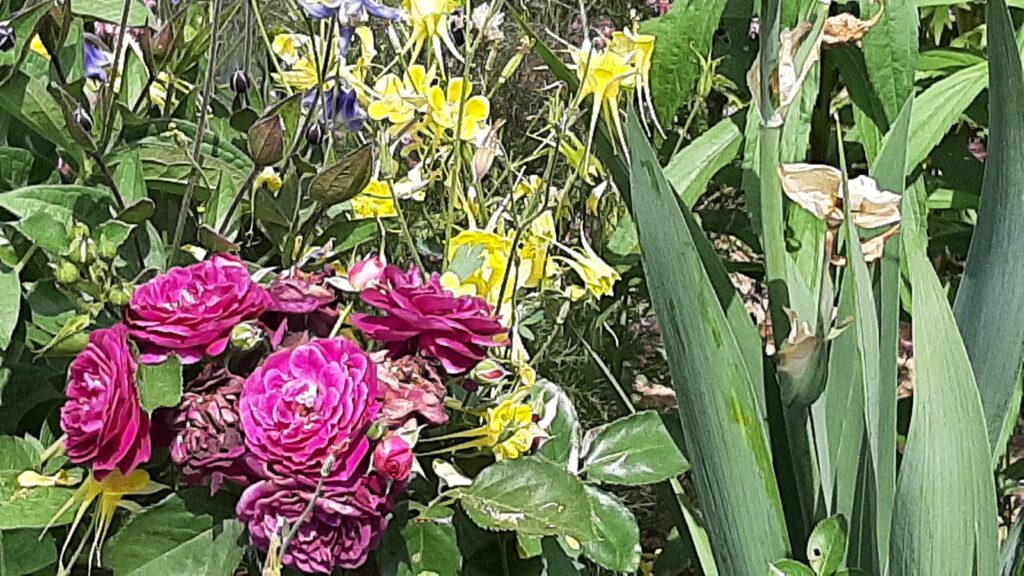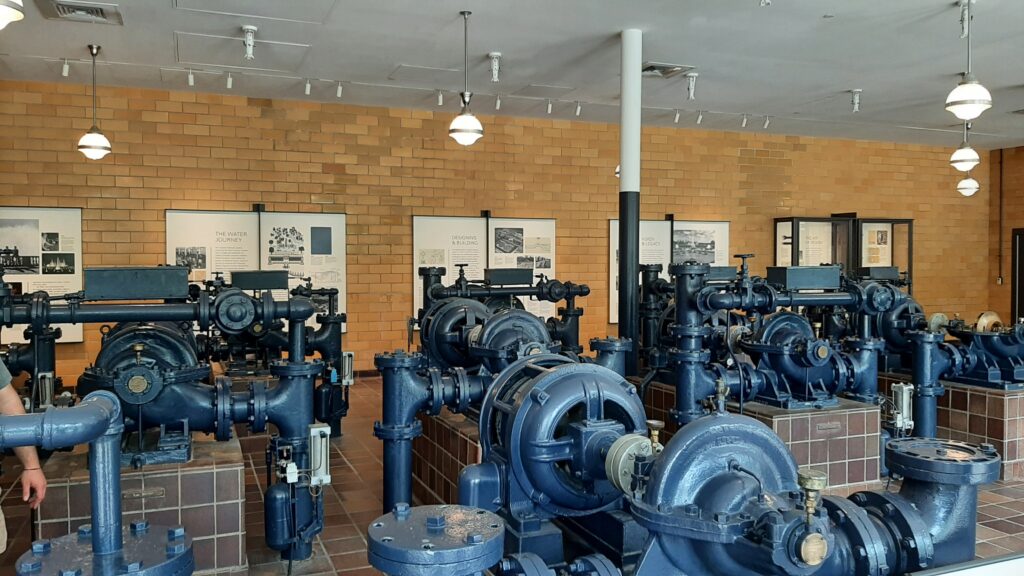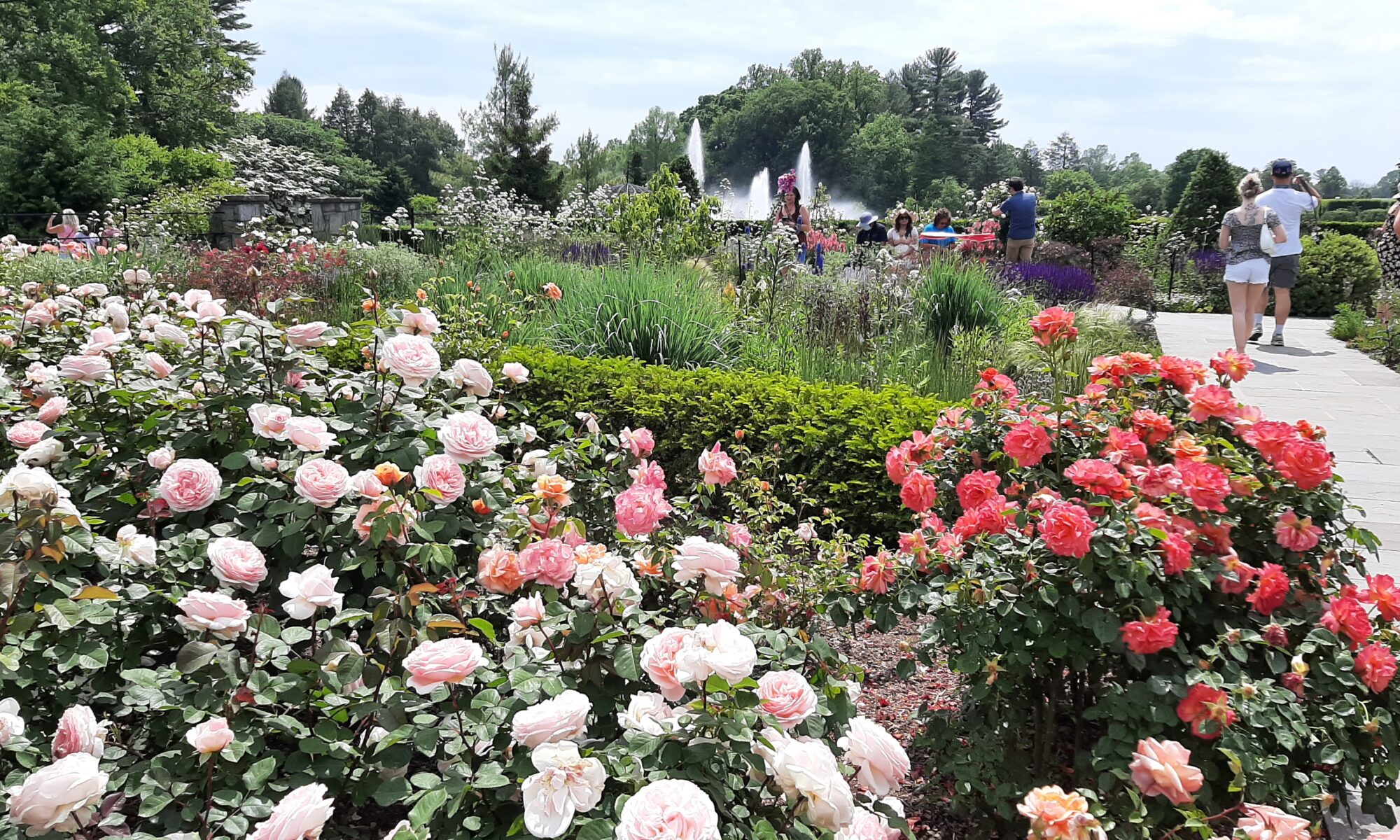For a quick 2 day trip over Memorial Day, we drove south to the Wilmington, Delaware area. There, in the land of the duPonts, are a lot of fantastic gardens and opulent homes. If you’re interested in visiting Nemours Estate and Longwood Gardens with kids, you’re in for a treat. .

Longwood Gardens is kind of like a theme park with plants. The parking lot is so large you need each section marked by letters, and parking people directing traffic – at least on a busy weekend. You also need timed tickets. Fortunately we had a glorious day and I remembered my sunblock (unfortunately a hat would have been a good call too, though I could have gotten one in the gift shop). And I had on my sneakers – also an excellent call, given the 200 acres of gardens, meadows and pathways you can explore.

Along the walkway to the right after entering Longwood Gardens. Copyright Deborah Abrams Kaplan
We’ll get to the history of Longwood Gardens later in this post. But know that Longwood has six districts that represent different regions. They differ by format and layout, as well as how manicured they are (Conservatory: very manicured. Meadow and forest: much less so).
House and Theater District

The House and Theater district is the first one you come to if you make a right after entering the property. There is a 600-foot flower garden, known as the Flower Garden Walk, which has a small fountain near the Open Air Theatre. There are some side flower gardens off the walkway, so don’t miss those.

Longwood Gardens staff change displays according to their schedule. The garden above was the only one we saw in progress. Some of the plants they use are grown from seed, some from cuttings in their production greenhouses. When they remove plants, they usually compost them. The bed above is along the flower walk.






While I don’t have a picture in this post, you can go into the Peirce-duPont House, which is now a museum explaining about the gardens. Pierre duPont bought the land and house from its previous owner, Joshua Peirce, in order to save the arboretum. He did not intend on turning it into a world-class garden with fountains. The house was really interesting and I highly recommend going in. While kids may not want to spend a lot of time in there, there are a lot of old pictures of how the gardens were created over the years, including the groundbreaking fountains. There are also short videos. The house holds Longwood’s first conservatory, which is relatively small in comparison to the one you’ll visit elsewhere in the gardens. You’ll also learn about some of the things the duPont company manufactured over the years, including products they invented such as Lucite, Freon, Teflon, and Mylar.

The house displays also share information about the duPont family and company. There are a lot of duPonts and we had a hard time keeping track of who was who in the family (especially after visiting Nemours Estate the day before). The big picture is that Eleuthere Irenee duPont came over from France in the early 1800s with his parents and sibling, wife and kids (about a dozen came over together). They knew how to manufacture gunpowder and Eleuthere started the duPont Company in 1802ish to do this, along the Brandywine River by Wilmington Delaware. Pierre duPont is Eleuthere’s great-grandson. He led the duPont Company at various times between 1902 and 1954, and also directed the development of General Motors from 1915 to 1929. A hundred and 50 years later, 632 members of the duPont family (including those still in France), came to Longwood Gardens for a reunion, covered by Life Magazine.
One of the highlights of Longwood Gardens are the fountains, which were progressive for that time, and a mechanical marvel. The Open Air Theater was built in 1913-1914. Pierre duPont installed the fountains on the stage floor in 1915. The theater has hosted hundreds of performances since it was built. The seating area holds 2,100 people. He added dressing rooms below the stage in 1926-1927, which can hold 100 performers. Check the schedule when you arrive (or before you arrive) to find out the times for this fountain performance and the main one. This one is a relatively short show (5 minutes or so), which is narrated with the history of this theater and some of the performers there over the years (TL:DR a lot of famous people perform here).
Fun facts: The theater has hosted more than 1,500 performances in more than 100 years. There are 750 illuminated jets with 600 lights, running daily in season. The duPonts had an annual garden party here.

The Lakes District
The Lakes District includes two lakes and the Italian Water Garden. It also includes the Canopy Cathedral Treehouse which will be fun for the kids to climb (and a bit less exciting for the adults, having done it myself).

Fun facts about the Italian Water Garden: The fountains have 600 water jets. They were inspired by a trip Pierre duPont took to a villa near Florence, Italy and one Alice duPont took to the Alhambra in Grenada. Enjoy the walk back through either the meadows or the forest.

The Conservatory District
The Conservatory is stunning. No way about it. Not only is there a lot to see in here, but they are building more rooms. One of my favorite parts was the Indoor Children’s Garden, which is full of whimsy and creative features the kids will love. The winding walkways are narrow and some arches are low, lending an intimate feel and kid-like size.

There are a lot of fun animals in here, including multiple fountains and water features. Even before you enter there’s a fountain where kids can “fish” with little nets to catch some toys. The children’s garden is 4,000 square feet, and includes herbs along the ramp to appeal to kids’ sense of smell in addition to sight.

There are a lot of hidden features, animals and bugs, and the kids will delight in finding many of them. The garden came from a European concept in the mid-1800s, when the gardens were used for learning and food production. By 1905, there were at least 100,000 gardens like this in Europe. Gardens like these started becoming more popular in the U.S. during the Industrial Age.

Wherever you wander in the Conservatory, you’ll find gorgeous flowers and water features.

After going down the spiral staircase from the top, you’ll end up in this dragon lair with a bubbling cauldron of dry ice.

In the main Conservatory, you’ll find the Orchid House, which holds hundred of orchids that are rotated five times a week. Guests will see something different when they come back. The collection began in the 1920s and the duPonts collected them from around the world. They now have 5,000 plants and 2,000 different taxa.





Don’t miss the Ballroom, which is in the Conservatory. It was built in 1929 to house Longwood Garden’s pipe organ, and the ballroom is 101 feet by 30 feet – with a stunning ceiling. A walk through the ballroom is just the start. Behind the long wall you can see a display about the organ itself, and how the organ works. Kids may not be all that interested in the signs, but to see the organ pipes – that is something to behold.

The organ console is on the left, so don’t forget to look at it on your way in or out of the organ display room. The Aeolian organ was built in Garwood, New Jersey for $122,700. The designer, Firmin Swinnen, was also the staff organist from 1923 to 1956. It was later rebuilt (and later restored).
In the museum, you’ll learn that an organ is a musical wind instrument with tuned whistles (pipes) that sit on boxes of compressed air. To play it, the keyboard operates valves feeding the air into the pipes to produce sound. Not surprisingly, organs were the most complex machines invented before the industrial revolution.

Organs are an ancient instrument, going back to 246 BCE. They were played in Alexandria, Egypt. And later at music festivals in Delphi in 90 BCE. Even Nero played the organ. Moving up in the years, the Wannamaker organ in Philadelphia’s department store, is from 1904. It is the largest fully-functioning pipe organ in the world, based on the number of pipes that play. it has 28,543 pipes and 6 keyboards. The organ in Atlantic City is bigger, but not functioning (according to Longwood, but is now 60-95% functional according to the links – it is being restored).

Longwood’s organ has 10,010 pipes and you can see 5,360 of them on display in the five rooms behind the organ holding the other 4,650 pipes. Each pipe room is separated by concrete walls. On the other side of the glass windows, are wooden shutters for seven of the nine rooms – they can be opened and closed by the organist to control the volume. The organ can be played from the console in the ballroom – or by a computer. There is an organ competition at Longwood in June.
The Green Wall in the Conservatory is spectacular (below). All those rooms on either side are individual restrooms. The walls are fern, 4,000 square feet of different ferns.


Alas, it was time for lunch. You’re not supposed to bring in outside food, but we did see people who did that. No one checked bags upon entering, and no staff seemed to care. There is a dining complex and outdoor beer garden. You can get food indoors and get beer outdoors, or order some quicker food from some of the stands outside (the pizza stand was closed when we were there).




We were surprised how much seating there was, even for a holiday weekend (we did eat slightly on the later side just in case). They have other alcoholic drinks too, and you can see the menus for the various Longwood Gardens dining options here. Look on the left side of that page for more menus.

Main Fountain Garden District
The Main Fountain Garden District includes multiple manicured gardens, what duPont saw as a “garden as grand theater.” You’ll find a rose garden, topiary garden, several fountain areas, and the pump house. Above is the topiary garden.





The area below includes hand-carved Italiante limestone stonework and sculptures. Above, are flowers from the rose garden.

Don’t miss the grotto which is hidden in a little passway underneath this fountain area. It’s peaceful and cool – great on a hot day! Below we were lucky to see the wisteria in bloom. (I think that’s what it is – if not, someone let me know in the comments).

This is all by the historical pumpuhouse built in 1930-31. It was designed by Pierre and his staff. You’ll see 18 of the original pumps and mechanical systems that powered the main fountain garden from 1931 to 2014. These pumps could recirculate 10,000 gallons per minute. and propel a fountain jet 130 feet high. There were also catchment systems so that debris would not clog up the pipes.


Check out the fountain show timing so you don’t miss the show. There are several places you can stand for the show. If you stand where the people below are, you’ll likely get wet. The show lasted for several patriotic songs. At night, the fountains include lights, so it’s a more colorful show.
If you go to Longwood Gardens with kids
Where: Longwood Gardens at 1001 Longwood Road, Kennett Square, PA
Longwood Gardens with kids: The Gardens offer a number of activity guides you can print at home to bring with you. They also highlight areas of interest to kids, including the Open Air Theater, Canopy Cathedral, Lookout Loft Treehouse, Indoor Children’s Garden, Topiary Garden, and some other places to run around and explore. They have various events and seasonal discovery boxes as well. You can bring strollers with you to Longwood Gardens.
Disclosure: We were provided with press tickets for review purposes. All opinions are my own.


One Reply to “Longwood Gardens With Kids”
Comments are closed.